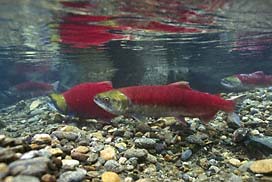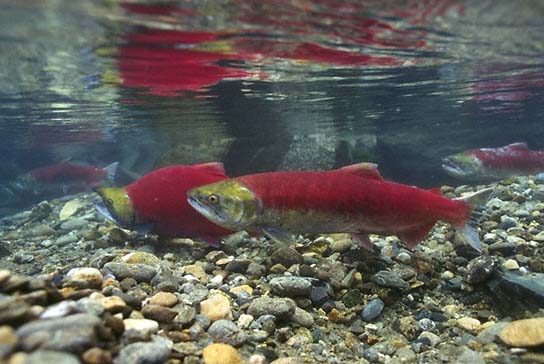Trouts and salmons
Description
To 33" (84 cm). Elongate, fusiform, moderately compressed. Marine coloration: bluish-green above, silvery below, with fine speckling but no spots. Freshwater coloration: bright red, head pale green; females may have green and yellow blotches. Snout bluntly pointed, mouth terminal; gill rakers long, slender, closely spaced, 28-40 on first arch. Adipose fin present.
Endangered Status
The Sockeye Salmon is on the U.S. Endangered Species List. Snake River populations are classified as endangered in Idaho, Oregon, and Washington. Populations from Ozette Lake, Washington, are classified as threatened. The Snake River Sockeye Salmon began their decline in the 1970s after hydroelectric dams were built along the Snake and Columbia Rivers. The original free flow of these rivers has been curtailed by more than 60 dams, and wild salmon populations have been reduced dramatically. Many salmon runs -- once extending over hundreds of miles of woodland streams -- have been destroyed entirely. Other factors contributing to the demise of Sockeyes are pollution, overfishing, and alterations to their habitat brought upon by development of adjoining land.
Related Species
Chum Salmon (O. keta) has all fins usually dark-tipped, dorsal can be pale at edges; has 18-26 gill rakers on first arch. Spawning adults have reddish bars and large, pale blotches on sides; tips of pelvic and anal fins white. Occurs from Arctic Ocean to S. California; coastal streams south to Sacramento River.
Habitat
Surface waters of open ocean and freshwater streams, rivers, and lakes containing tributary streams for spawning.
Range
From Bering Straight to Sacramento River, California; introduced elsewhere in northern lakes.
Discussion
Sockeye Salmon spawn during summer in small tributaries of lakes, where the young spend 1 to 3 years before migrating to the ocean. After living at sea for 2 to 4 years, maturing adults return to their home stream. Sockeye Salmon have the greatest commercial value of all the Pacific salmons, although few are caught by anglers in the ocean because they rarely strike lures or trolled baits.


